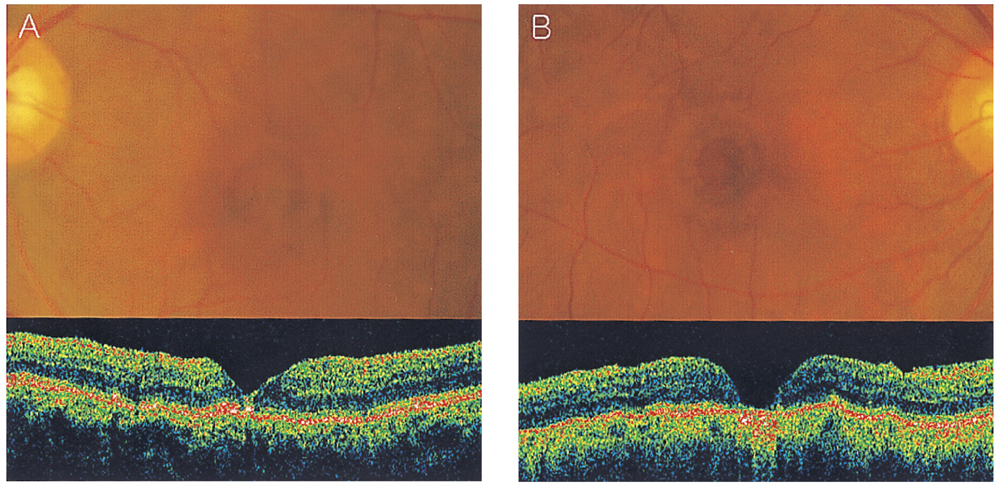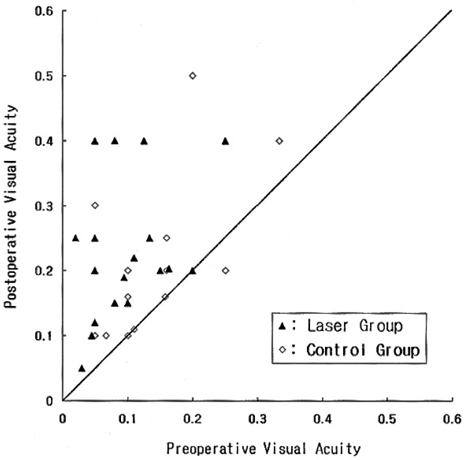Korean J Ophthalmol.
2006 Jun;20(2):93-98. 10.3341/kjo.2006.20.2.93.
Laser Photocoagulation as Adjuvant Therapy to Surgery for Large Macular Holes
- Affiliations
-
- 1Department of Ophthalmology, Sungkyunkwan University, School of Medicine, Samsung Medical Center, Seoul, Korea. swkang@smc.samsung.co.kr
- KMID: 1099042
- DOI: http://doi.org/10.3341/kjo.2006.20.2.93
Abstract
- PURPOSE: To evaluate the effectiveness of laser photocoagulation as adjuvant therapy in the treatment of large macular holes. METHODS: A randomized clinical trial. Thirty-one eyes from 29 subjects with idiopathic macular holes of diameters larger than 400 micrometer were randomized into a laser group and a control group. All eyes underwent vitrectomy with peeling of the internal limiting membrane. Contrary to the control group eyes, the laser group eyes underwent laser photocoagulation at the center of the macular hole before vitrectomy. Visual acuity and anatomic outcomes assessed by optical coherence tomography (OCT) were analyzed 3 months after surgery. RESULTS: On postoperative OCT, closure of the macular hole was noted in 17 of the 18 (94.4%) laser group eyes and 10 of the 13 (76.9%) control group eyes. Hole closure without bare retinal pigment epithelium was observed in 16 eyes in the laser group and 6 eyes in the control group (P<0.05). The amount of improvement in logMAR visual acuity 3 months after surgery was 0.40+/-0.29 in the laser group, and 0.19+/-0.23 in the control group (P<0.05). CONCLUSIONS: Laser photocoagulation constitutes a potent adjuvant therapy that may improve anatomical and visual outcomes of surgery for macular holes larger than 400 micrometer.
MeSH Terms
Figure
Reference
-
1. Gass JDM. Idiopathic senile macular hole. Its early stages and pathogenesis. Arch Ophthalmol. 1988. 106:629–639.2. Funata M, Wendel RT, de la Cruz Z, Green WR. Clinicopathologic study of bilateral macular holes treated with pars plana vitrectomy and gas tamponade. Retina. 1992. 12:289–298.3. Madreperla SA, Geiger GL, Funata M, et al. Clinicopathologic correlation of a macular hole treated by cortical vitreous peeling and gas tamponade. Ophthalmology. 1994. 101:682–686.4. Smiddy WE, Feuer W, Cordahi G. Internal limiting membrane peeling in macular hole surgery. Ophthalmology. 2001. 108:1471–1478.5. Glaser BM, Michels RG, Kuppermann BD, et al. Transforming growth factor-beta2 for the treatment of full-thickness macular holes. A prospective randomized study. Ophthalmology. 1992. 99:1162–1172.6. Smiddy WE, Glaser BM, Thompson JT, et al. Transforming growth factor-beta 2 significantly enhances the ability to flatten the rim of subretinal fluid surrounding macular holes. Preliminary anatomic results of a multicenter prospective randomized study. Retina. 1993. 13:296–301.7. Paques M, Chastang C, Mathis A, et al. Effect of autologous platelet concentrate in surgery for idiopathic macular hole. Results of a multicenter, double-masked, randomized trial. Ophthalmology. 1999. 106:932–938.8. Liggett PE, Skolik DS, Horio B, et al. Human autologous serum for the treatment of full-thickness macular holes. Ophthalmology. 1995. 102:1071–1076.9. Thompson JT, Smiddy WE, Williams GA, et al. Comparison of recombinant transforming growth factor-beta-2 and placebo as an adjunctive agent for macular hole surgery. Ophthalmology. 1998. 105:700–706.10. Ezra E, Gregor ZJ. For the macular hole study group. Surgery for idiopathic full-thickness macular hole. Two-year results of randomized clinical trial comparing natural history, vitrectomy, and vitrectomy plus autologous serum: Moorfields macular hole study group report No.1. Arch Ophathlmol. 2004. 122:224–236.11. Banker AS, Freeman WR, Azen SP, Lai MY. Vitrectomy for Macular Hole Study Group. A multicentered clinical study of serum as adjuvant therapy for surgical treatment of macular holes. Arch Ophthalmol. 1999. 117:1499–1502.12. Del Priore LV, Kaplan HJ, Bonham RD. Laser photocoagulation and fluid-gas exchange for recurrent macular hole. Retina. 1994. 4:381–382.13. Ohana E, Blumenkranz MS. Treatment of reopened macular hole after vitrectomy by laser and outpatient fluid-gas exchange. Ophthalmology. 1998. 105:1398–1403.14. Min WK, Lee JH, Ham DI. Macular hole surgery in conjunction with endolaser photocoagulation. Am J Ophthalmol. 1999. 127:306–311.15. Matsumoto M, Yoshimura N, Honda Y. Increased production of transforming growth factor-beta 2 from cultured human retinal pigment epithelial cells by photocoagulation. Invest Ophthalmol Vis Sci. 1994. 35:4245–4252.16. Ikuno Y, Kamei M, Saito Y, et al. Photocoagulation and fluid-gas exchange to treat persistent macular holes after prior vitrectomy. A pilot study. Ophthalmology. 1998. 105:1411–1418.17. Johnson RN, McDonald HR, Schatz H, Ai E. Outpatient postoperative fluid-gas exchange after early failed vitrectomy surgery for macular hole. Ophthalmology. 1997. 104:2009–2013.18. Ikuno Y, Kamei M, Ohno T, et al. Photocoagulation and fluid-gas exchange for persistent macular hole. Retina. 1996. 16:264–266.19. Ferris FL III, Kassoff A, Bresnick GH, Bailey I. New visual acuity charts for clinical research. Am J Ophthalmol. 1982. 94:91–96.20. Kang SW, Ahn K, Ham DI. Types of macular hole closure and their clinical implications. Br J Ophthalmol. 2003. 87:1015–1019.21. Ullrich S, Haritoglou C, Gass C, et al. Macular hole size as a prognostic factor in macular hole surgery. Br J Ophthalmol. 2002. 86:390–393.22. Amari F, Ohta K, Kojima H, Yoshimura N. Predicting visual outcome after macular hole surgery using scanning laser ophthalmoscope microperimetry. Br J Ophthalmol. 2001. 85:96–98.23. Ip MS, Baker BJ, Duker JS, et al. Anatomical outcomes of surgery for idiopathic macular hole as determined by optical coherence tomography. Arch Ophthalmol. 2002. 120:29–35.24. Benson WE, Cruickshanks KC, Fong DS, et al. Surgical management of macular holes: a report by the American Academy of Ophthalmology. Ophthalmology. 2001. 108:1328–1335.
- Full Text Links
- Actions
-
Cited
- CITED
-
- Close
- Share
- Similar articles
-
- The Effects of Laser Photocoagulation on Reopened Macular Holes, as Assessed by Optical Coherence Tomography
- Treatment of Failed Macular Hole after Vitrectomy by Outpatient Gas Injection and Laser Photocoagulation
- Laser Photocoagulation in Diabetic Macular Edema
- Laser Photocoagulation in Diabetic Macular Edema
- Visual Results after Grid Laser Photocoagulation for Diffuse Diabetic Macular Edema



